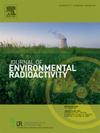Dynamic models for estimating radiation doses to hydrobionts in a freshwater ecosystem
IF 1.9
3区 环境科学与生态学
Q3 ENVIRONMENTAL SCIENCES
引用次数: 0
Abstract
A model of radionuclide transfer in freshwater bodies, along with dosimetric models for estimating doses to aquatic biota species (including phytoplankton, zooplankton, zoobenthos, and fish), is presented. The results of the reconstruction of radiation doses to aquatic organisms living in the closed (non-flowing, lentic) Lake Uruskul, located in the vicinity of the Kyshtym accident, are provided. The contributions of the main dose-forming radionuclides, as well as both internal and external exposures, to the doses received by aquatic organisms over the 50 years following the Kyshtym accident are discussed. It is shown that benthic organisms received the highest doses (2.6–8.3 Gy per day), while zooplankton experienced somewhat lower doses (up to 3.3 Gy per day). Fish received doses of up to 4 mGy per day during the first 100 days. Phytoplankton, with doses reaching up to 0.5 Gy per day, occupied an intermediate position in this sequence. These doses could lead to long-term radiation effects.
估算淡水生态系统中水生生物所受辐射剂量的动态模型。
介绍了淡水水体放射性核素转移模型,以及估算水生生物群物种(包括浮游植物、浮游动物、底栖生物和鱼类)所受剂量的剂量学模型。提供了对生活在克什特姆事故附近封闭(非流动、透镜状)的乌鲁斯库尔湖中的水生生物的辐射剂量的重建结果。文中讨论了在克什特姆事故发生后的 50 年间,主要放射性核素的剂量形成以及内部和外部照射对水生生物所受剂量的影响。结果表明,底栖生物受到的剂量最高(每天 2.6-8.3 Gy),而浮游动物受到的剂量稍低(每天最多 3.3 Gy)。在最初的 100 天里,鱼类每天接受的剂量高达 4 mGy。浮游植物在这一序列中处于中间位置,每天的剂量高达 0.5 Gy。这些剂量可能导致长期辐射影响。
本文章由计算机程序翻译,如有差异,请以英文原文为准。
求助全文
约1分钟内获得全文
求助全文
来源期刊

Journal of environmental radioactivity
环境科学-环境科学
CiteScore
4.70
自引率
13.00%
发文量
209
审稿时长
73 days
期刊介绍:
The Journal of Environmental Radioactivity provides a coherent international forum for publication of original research or review papers on any aspect of the occurrence of radioactivity in natural systems.
Relevant subject areas range from applications of environmental radionuclides as mechanistic or timescale tracers of natural processes to assessments of the radioecological or radiological effects of ambient radioactivity. Papers deal with naturally occurring nuclides or with those created and released by man through nuclear weapons manufacture and testing, energy production, fuel-cycle technology, etc. Reports on radioactivity in the oceans, sediments, rivers, lakes, groundwaters, soils, atmosphere and all divisions of the biosphere are welcomed, but these should not simply be of a monitoring nature unless the data are particularly innovative.
 求助内容:
求助内容: 应助结果提醒方式:
应助结果提醒方式:


